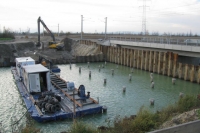S1/S2/A5 Motorways - PPP Region East
Client: Consortium PPP Region East
Development Period: 2007 to 2010
The first road construction project in Austria conducted as a Public Private Partnership (PPP) project comprises of 51.5 km of new roads in the eastern region of Austria. The northern part of Vienna is encircled by three multilane motorway sections, namely the S1 West, S1 East and S2. Near Eibesbrunn, the southern section of the A5 motorway branches off to the north and connects the urban catchment area of Mistelbach with Vienna.
The concession project included the financing, planning, construction, operation and maintenance for a period of 33 years. It consists of 51.5 km of motorways (mostly four-lane), six open cut tunnels with a total length of 7.0 km, 1.4 km of mined tunnel, 74 other engineered structures, 14 junctions, two service areas and numerous noise protection walls.
BGG Consult (commissioned by the provincial government of Niederösterreich) had already been responsible for the geotechnical and hydrogeological consulting of the environmental impact assessment procedure and the building permit application. During this phase, subsoil exploration works were supervised and processed. Based on these, geotechnical and hydrogeological expert’s reports were compiled.
During construction, BGG Consult was commissioned by the construction consortium to supervise all geotechnical and hydrogeological activities. This included the optimisation of foundations, building pits and dewatering concepts as well as the supervision and monitoring of the extensive earth works.
In addition, BGG Consult was responsible for the preservation of the hydrogeological evidence.
Construction below ground water:
The Stetten and Kreuzenstein antipollution tunnels (APT) as well as the underpasses of the Northern Railway Line and the Vienna - Laa/Thaya Railway Line are situated in the sections of the S1. For all of these, structures had to be built below the ground water level. In the case of the Stetten APT, the dewatering was carried out with open methods. In addition, pipes for tension release were lowered in order to avoid soil heave. The Kreuzenstein APT is built under the protection of closed sheet pile walls. In this case, the dewatering was done by means of bored wells within the construction pit. This method was also used at the S2 tunnel and the crossing of the Vienna - Laa/Thaya Railway Line. In the case of the underpass below the Northern Railway Line, the impervious layer was found 25 m below surface and the aquifer could not be sealed off by sheet piles. Therefore, the concrete floor was cast below ground water, in between sheet piles. The buoyancy control was secured by means of driven ductile steel piles.
Prior to the implementation of the measures, BGG Consult performed numerical ground water calculations in order to identify the impact on the hydrogeological environment.
November 2010
